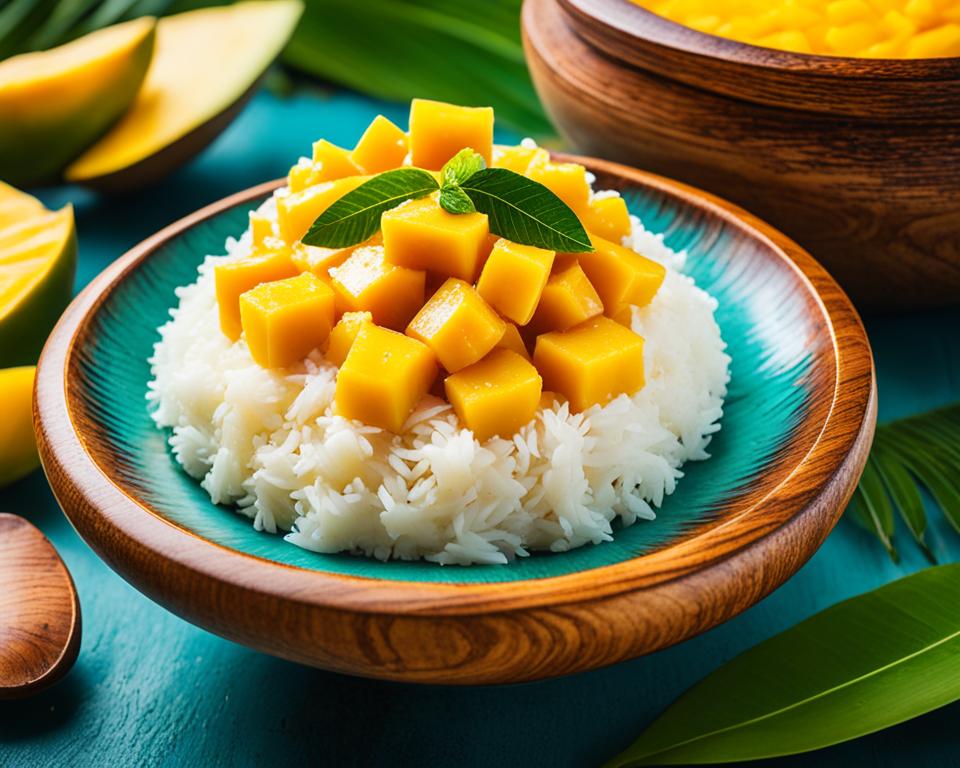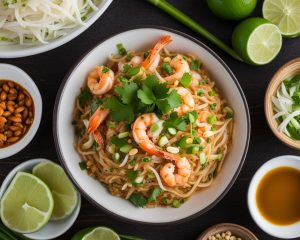
Welcome to our article on Bali Thai Mango Sticky Rice, a truly tropical delight that perfectly embodies the flavors of authentic Balinese cuisine and the essence of a traditional Thai dessert. This mouthwatering treat combines the sweetness of sticky rice with the lusciousness of ripe mango, resulting in a delightful blend of exotic Asian flavors.
As you journey through this article, we will take you on a sensory adventure, exploring the origins of Bali Thai Mango Sticky Rice and its popularity as a beloved dessert in Southeast Asia. We’ll also delve into the art of sticky rice preparation and the significance of coconut milk sauce, both integral components in creating this irresistible dish.
If you’re planning a trip to Bali or simply looking to indulge in an authentic taste of Southeast Asia, tasting Bali Thai Mango Sticky Rice should be high on your list. We’ll guide you through the experience of savoring this tropical delicacy in Bali, where it is considered a must-try dish for both locals and tourists alike.
Furthermore, we’ll uncover the perfect combination of mango and sticky rice, showcasing how the natural sweetness of the fruit enhances the texture and flavor of the rice, resulting in a delightful tropical fruit dessert that will transport your taste buds to paradise.
Are you eager to try your hand at making Bali Thai Mango Sticky Rice at home? We’ve got you covered with a step-by-step recipe and valuable tips to ensure your creation is bursting with authentic flavors.
Join us as we explore the culinary connection between Bali and Thailand, and discover how dishes like Bali Thai Mango Sticky Rice bridge cultures and reflect the rich tapestry of Southeast Asian cuisine.
So, whether you’re a seasoned fan or a newcomer to the world of traditional Thai desserts, come along and indulge in the irresistible allure of Bali Thai Mango Sticky Rice, a sweet treat that knows no boundaries and is sure to bring joy to any occasion.
Read more interesting information at ::beauty-hair-news
What is Bali Thai Mango Sticky Rice?
Bali Thai Mango Sticky Rice is a delectable dessert that tantalizes taste buds with its combination of sweet sticky rice with mango. This culinary masterpiece brings together the exotic Asian flavors of perfectly cooked sticky rice and the succulent sweetness of ripe mango.
The preparation of Bali Thai Mango Sticky Rice involves careful steps to ensure that each element contributes to the overall taste and texture. The sweet sticky rice is soaked, steamed, and gently infused with the aroma of pandan leaves, creating a fragrant base. Meanwhile, ripe mangoes are sliced into tender pieces, ready to be layered atop the flavorful rice.
“The combination of sweet sticky rice and fresh mango creates a delightful blend of exotic Asian flavors that is beloved worldwide.”
The magic of Bali Thai Mango Sticky Rice lies in the harmonious union of textures and tastes. The sticky rice’s delicate chewiness contrasts with the juicy, tropical succulence of the mango. Each spoonful is a sensory delight, with the soft rice grains gently clinging to the luscious fruit, providing a rich and satisfying mouthfeel.
With its heavenly blend of textures and exotic flavors, it’s no wonder that Bali Thai Mango Sticky Rice has become an irresistible treat for both locals and visitors alike. This culinary gem encapsulates the essence of Southeast Asian cuisine, offering a taste of authenticity and tradition.
Experience the sweet indulgence of Bali Thai Mango Sticky Rice and allow the exotic Asian flavors to transport you to a tropical paradise.
The Origins of Bali Thai Mango Sticky Rice
Bali Thai Mango Sticky Rice is a popular dessert in Southeast Asia, cherished for its delicious tropical flavors. This delightful sweet treat has its roots in the culinary traditions of both Bali, Indonesia, and Thailand, making it a fusion of two diverse cultures.
The origins of Bali Thai Mango Sticky Rice can be traced back to traditional Thai desserts. In Thailand, sticky rice is a staple ingredient commonly used in desserts. The cooking technique involves soaking glutinous rice overnight and then steaming it to achieve its signature sticky texture.
The addition of mango elevates the dish to a whole new level by infusing it with the vibrant flavors of the tropics. The luscious sweetness of ripe mango perfectly complements the sticky rice, creating a harmonious blend of taste and texture.
Over the years, this mouthwatering dessert has gained immense popularity throughout Southeast Asia and beyond. Its exotic appeal and delightful combination of flavors have captured the hearts and taste buds of dessert lovers all over the world.
“Bali Thai Mango Sticky Rice is a true culinary masterpiece, showcasing the rich and diverse flavors of Southeast Asia. Its popularity as a delicious tropical dessert is a testament to its irresistible taste.”
Experiencing Bali Thai Mango Sticky Rice in Bali
When visiting Bali, indulging in the local cuisine is a must-do, and one dish that should be at the top of your list is Bali Thai Mango Sticky Rice. This delightful dessert is a true reflection of the island’s vibrant flavors and exotic ingredients.
Imagine sinking your teeth into a spoonful of sweet sticky rice infused with the aromatic essence of fresh mango. The combination of fluffy rice, creamy coconut milk, and the tropical sweetness of ripe mango creates a heavenly fusion of textures and flavors that is truly unforgettable.
“Tasting Bali Thai Mango Sticky Rice is like taking a journey through the lush landscapes and coastal beauty of Bali. Each bite transports you to a world of tropical delight.”
As you savor this tantalizing dessert, you’ll understand why it is considered a must-try food for anyone visiting Bali. The distinct flavors and unique preparation make it a standout dish that embodies the essence of the island.
To enhance your Bali food adventure, we recommend trying Bali Thai Mango Sticky Rice at one of the local Balinese restaurants or street food stalls. You’ll find that each establishment adds its own touch of creativity and flair to this beloved dessert, making every bite a delightful surprise.
Pairing the Bali Thai Mango Sticky Rice with a cup of traditional Balinese coffee or a refreshing tropical fruit juice elevates the experience even further. The combination of flavors creates a symphony of taste that will leave you craving for more.
Whether you’re exploring the vibrant streets of Ubud or relaxing on the beautiful beaches of Kuta, make sure to treat yourself to this culinary gem. Bali Thai Mango Sticky Rice is not just a dessert; it’s a sensory journey that heightens your appreciation for Balinese culture and cuisine.
So, when you plan your next vacation to Bali, be sure to put Bali Thai Mango Sticky Rice at the top of your food must-try list. It’s an experience that will immerse you in the exotic flavors of the island and create lasting memories of your time in Bali.
The Perfect Combination: Mango and Sticky Rice
Mango and sticky rice, when brought together, create a delightful tropical fruit dessert that is loved by many. This harmonious pairing showcases the natural sweetness of the mango, perfectly complementing the sticky rice’s unique texture and flavor.
The sweetness of the mango adds a burst of refreshing tropical flavors to the dish, while the sticky rice provides a satisfying chewiness. The combination of the two creates a contrast that tantalizes the taste buds and leaves a lasting impression.
This tropical fruit dessert is a popular choice in Southeast Asian cuisine, particularly in Thailand, where it is known as “khao niew mamuang.” Thai mango and sticky rice is often enjoyed as a refreshing treat on hot summer days, or as a sweet ending to a delicious meal.
What makes this combination truly special is the balance it achieves between the creaminess of the mango and the delicate stickiness of the rice. Each bite offers a harmonious blend of flavors and textures, making it a dessert that is both satisfying and indulgent.
To truly appreciate the magic of mango and sticky rice, consider the visual appeal as well. The vibrant colors of the ripe mango and the white sticky rice create an enticing display that is as beautiful as it is delicious.
This image perfectly captures the essence of this tropical fruit dessert, with fresh mango slices elegantly resting on a bed of sticky rice. It serves as a visual reminder of the delightful experience that awaits those who indulge in this delicious combination.
Whether you are a fan of mango, a lover of sticky rice, or simply a dessert enthusiast looking for a taste of the tropics, mango and sticky rice is sure to satisfy your cravings.
Andhra Pradesh Mango Pudding Recipe
For those who want to try their hand at recreating this delectable dessert at home, here is a variation inspired by the flavors of Andhra Pradesh:
| Ingredients | Instructions |
|---|---|
|
|
This Andhra Pradesh-inspired mango pudding adds a unique twist to the classic mango and sticky rice combination, infusing it with the flavors of coconut and a hint of sweetness. Give it a try and enjoy a taste of the tropics in your own kitchen!
Uncovering the Art of Sticky Rice Preparation
When it comes to creating the perfect Bali Thai Mango Sticky Rice, the key lies in mastering the art of sticky rice preparation. This traditional Thai cooking method ensures that the rice achieves the ideal texture and consistency required for this delectable dessert.
The first step in this culinary process is soaking the sticky rice overnight. Also known as glutinous rice, this variety of rice is different from the regular jasmine or basmati rice commonly used in savory dishes. Soaking the rice allows it to absorb water fully and soften, resulting in a tender and sticky texture.
After the soaking process, the next crucial step is steaming the sticky rice. Traditionally, the rice is placed in a bamboo steamer lined with a thin cotton cloth. This method allows the rice to cook slowly, evenly, and retain its moisture. The steaming process infuses the rice with a subtly sweet taste and a sticky consistency that is perfect for Bali Thai Mango Sticky Rice.
Throughout the steaming process, it’s important to maintain a consistent level of steam, ensuring that the rice cooks thoroughly without becoming overly mushy. To achieve this, it’s recommended to use a traditional Thai sticky rice steamer or a regular steamer lined with a cloth that allows the steam to flow evenly. The goal is to achieve a sticky rice consistency that holds together but is still soft and tender.
Properly cooked sticky rice should possess a delightful chewiness and a slightly sticky texture, allowing it to perfectly absorb the flavors of the mango and coconut milk sauce.
Mastering the art of sticky rice preparation is a testament to the rich culinary heritage and the attention to detail inherent in traditional Thai cooking methods. The time and effort invested in preparing the sticky rice for Bali Thai Mango Sticky Rice result in a dessert that captivates the palate with its unique blend of textures and flavors.
As the image above illustrates, the sticky rice exemplifies the cooking technique used to achieve its desired consistency. This captivating visual showcases the importance of proper sticky rice preparation in crafting an authentic Bali Thai Mango Sticky Rice.
The Secret Sauce: Coconut Milk
When it comes to Bali Thai Mango Sticky Rice, there’s one ingredient that adds a creamy and flavorful touch to this delectable dessert: coconut milk sauce. This sauce, made from the rich and creamy extract of coconut meat, is a staple in Thai cuisine and plays a vital role in enhancing the overall taste and texture of the dish.
Coconut milk sauce is known for its smooth consistency and subtly sweet flavor. It perfectly complements the sweetness of the mango and sticky rice, creating a harmonious balance of tropical flavors. The creamy richness of the coconut milk adds depth and complexity to each bite, making it a standout element in Bali Thai Mango Sticky Rice.
Thai cuisine is renowned for its skillful use of coconut milk in various dishes, and this sauce is no exception. Its versatility extends beyond desserts, as it is also a common ingredient in curries, soups, and other traditional Thai recipes. The natural creaminess and unique taste of coconut milk make it a beloved and essential component in Thai cooking.
For those with dietary restrictions, coconut milk sauce is a great option as it is often naturally dairy-free and vegan-friendly. Its smooth and luscious texture provides a satisfying richness that rivals traditional dairy-based sauces, making it a great alternative for those seeking a plant-based option.
When preparing Bali Thai Mango Sticky Rice, the coconut milk sauce is often poured generously over the rice and mango, allowing it to seep into the grains and infuse them with its delightful flavor. The result is a mouthwatering dessert that showcases the best of tropical ingredients and Thai culinary expertise.
To truly appreciate the significance of coconut milk sauce in Bali Thai Mango Sticky Rice, it’s important to understand its role as a Thai cuisine staple and the undeniable influence it has on the dish’s overall taste and appeal. The next time you indulge in this heavenly dessert, take a moment to savor the creamy delight of coconut milk sauce that elevates the experience to new heights.
Benefits of Coconut Milk Sauce in Bali Thai Mango Sticky Rice
| Benefits | Description |
|---|---|
| Enhanced Creaminess | The coconut milk sauce adds a velvety smoothness to the sticky rice, mango, and other ingredients, enhancing their texture. |
| Rich Flavor | The subtle sweetness and distinct flavor of coconut milk elevate the taste of the dessert, creating a tropical sensation. |
| Authentic Thai Touch | Coconut milk sauce is a traditional ingredient in Thai cuisine, giving the dish an authentic Thai flavor. |
| Dairy-Free Option | Coconut milk is often suitable for those with dairy restrictions, providing a luscious alternative to dairy-based sauces. |
Variations and Innovations on Bali Thai Mango Sticky Rice
While Bali Thai Mango Sticky Rice is traditionally prepared with sweet sticky rice and fresh mango, modern chefs and home cooks have been experimenting with exciting variations of this beloved dessert. These innovative twists and creative recipes add a unique touch to the traditional dish while maintaining the essence of its tropical flavors.
One popular variation is the addition of coconut caramel to the sticky rice, giving it a rich and indulgent flavor. The sweet and creamy caramel sauce adds a luscious sweetness that perfectly complements the fresh mango slices. It’s a delightful combination of textures and flavors that take this classic dessert to new heights.
For those looking to add a refreshing twist to Bali Thai Mango Sticky Rice, incorporating citrus fruits like oranges or grapefruits can provide a vibrant burst of flavor. The tanginess of the citrus fruits cuts through the sweetness of the rice and mango, creating a well-balanced and zesty dessert that is perfect for summer.
An unexpected but delicious variation involves infusing the sticky rice with pandan flavor. Pandan leaves are commonly used in Southeast Asian desserts for their aromatic and fragrant qualities. The pandan-infused sticky rice adds a subtle and unique taste to the dish, making it a delightful surprise for the taste buds.
“The key to creating innovative variations of Bali Thai Mango Sticky Rice is to play with different ingredients and flavors while keeping the essence of the dessert intact. It’s about incorporating modern twists that enhance the overall experience without losing the traditional charm.” – Chef Jasmine Lee
For those who enjoy a bit of crunch in their desserts, adding toasted coconut flakes or crushed nuts such as peanuts or cashews can provide a delightful textural contrast to the soft and sticky rice. The nuttiness and crunchiness add an interesting dimension to the dish, elevating it to a whole new level.
For a more indulgent and decadent treat, some chefs have even experimented with chocolate-infused sticky rice as a base for Bali Thai Mango Sticky Rice. The rich and velvety chocolate flavors blend harmoniously with the sweetness of the mango, creating a dessert that chocolate lovers will swoon over.
These variations and innovations on Bali Thai Mango Sticky Rice showcase the endless possibilities of this treasured dessert. By combining different flavors, textures, and ingredients, chefs and home cooks alike can create unique and exciting dishes that pay homage to the traditional roots while embracing modern culinary creativity.
| Variation | Description |
|---|---|
| Coconut Caramel Sticky Rice with Fresh Mango | A rich and indulgent twist on the classic dessert, with the addition of creamy coconut caramel sauce. |
| Citrus-infused Sticky Rice with Mango | A refreshing variation that incorporates tangy citrus fruits to add a zesty burst of flavor to the dish. |
| Pandan-flavored Sticky Rice with Mango | An unexpected twist, with the aromatic and fragrant pandan leaves infusing the sticky rice. |
| Sticky Rice with Toasted Coconut Flakes and Mango | Provides a delightful crunch to the dish, with toasted coconut flakes or crushed nuts adding texture. |
| Chocolate-infused Sticky Rice with Mango | A decadent variation that combines the rich flavors of chocolate with the sweetness of mango. |
Pairing Bali Thai Mango Sticky Rice with Local Delights
To elevate your culinary experience with Bali Thai Mango Sticky Rice, consider pairing it with traditional Indonesian desserts. This delightful combination not only adds variety to your palate but also creates a harmonious blend of flavors and textures that will leave you craving for more.
Indonesia is known for its rich and diverse culinary heritage, with a wide array of traditional desserts that perfectly complement the tropical flavors of Bali Thai Mango Sticky Rice. These desserts showcase the unique ingredients and techniques that make Indonesian sweets stand out.
One such traditional Indonesian dessert is klepon, which consists of sticky rice balls filled with palm sugar and covered in grated coconut. The chewy texture of the sticky rice pairs beautifully with the creamy sweetness of Bali Thai Mango Sticky Rice, creating a delightful contrast.
Bubur ketan hitam, or black sticky rice porridge, is another popular Indonesian dessert that pairs well with Bali Thai Mango Sticky Rice. The rich and comforting flavors of the porridge, combined with the sweet and tangy taste of the mango, create a delightful balance that is sure to satisfy your sweet tooth.
For those who prefer a lighter option, cendol is a refreshing choice. This traditional Indonesian dessert features pandan-flavored jelly noodles, coconut milk, and palm sugar syrup. The combination of the cool and creamy cendol with the warm and luscious Bali Thai Mango Sticky Rice creates a delightful contrast that will have you coming back for more.
Indulge in the culinary delights of Bali Thai Mango Sticky Rice by pairing it with traditional Indonesian desserts. The perfect balance of flavors and textures will transport you to a tropical paradise with each bite.
| Traditional Indonesian Dessert | Description |
|---|---|
| Klepon | Sticky rice balls filled with palm sugar and covered in grated coconut |
| Bubur ketan hitam | Black sticky rice porridge with a rich and comforting flavor |
| Cendol | Pandan-flavored jelly noodles with coconut milk and palm sugar syrup |
Discover the unparalleled sensory adventure of combining Bali Thai Mango Sticky Rice with these traditional Indonesian desserts. It’s a gastronomic experience that captures the essence of Southeast Asian cuisine and showcases the diverse range of flavors that will leave you craving for more.
Bali Thai Mango Sticky Rice: A Sweet Treat for All Occasions
Indulge in the versatility of Bali Thai Mango Sticky Rice, a dessert that knows no boundaries when it comes to delighting your taste buds. Whether it’s a casual get-together or a special celebration, this versatile dessert is guaranteed to bring joy and satisfaction to any occasion.
The combination of sweet sticky rice and juicy, ripened mango creates a celebratory dish that embodies the essence of tropical indulgence. The delicate balance of textures and flavors in each bite will transport you to a paradise of delectable sweetness, making every moment worth savoring.
Unveil the vibrant colors and enticing aroma of this dessert as you enjoy its versatility. Bali Thai Mango Sticky Rice is equally suited for a relaxed afternoon tea or as a grand finale to a lavish banquet. Its adaptability makes it a crowd-pleaser, appealing to a wide range of palates with its unique blend of exotic Asian flavors.

Whether it’s a summer gathering, a festive celebration, or simply a joyful moment of self-indulgence, Bali Thai Mango Sticky Rice is there to elevate the experience. Its enticing flavors and visually captivating presentation make it a dessert that sparks not only delight but also a sense of occasion.
So, don’t miss out on the opportunity to add a touch of tropical bliss to your next gathering. As you take a spoonful of Bali Thai Mango Sticky Rice, let the flavors transport you on a culinary journey that celebrates the beauty of a versatile dessert fit for any and every occasion.
How to Make Bali Thai Mango Sticky Rice at Home
If you’re craving the tropical flavors of Bali Thai Mango Sticky Rice but can’t make it to a restaurant, fear not! With this homemade mango sticky rice recipe, you can recreate this delectable dessert in the comfort of your own kitchen. Follow this step-by-step preparation guide to achieve the perfect balance of flavors and indulge in a taste of Southeast Asia.
Ingredients
- 1 cup glutinous rice (also known as sweet sticky rice)
- 1 ripe mango, peeled and sliced
- 1 cup coconut milk
- 1/4 cup sugar
- 1/4 teaspoon salt
Instructions
- Start by rinsing the glutinous rice under cold water until the water runs clear. This removes any excess starch.
- Soak the rice in water for at least 4 hours or preferably overnight. This will ensure a perfect sticky texture when cooked.
- Drain the soaked rice and transfer it to a steamer lined with a cheesecloth or banana leaves to prevent sticking.
- Steam the rice over medium heat for 20-25 minutes, or until tender and fully cooked.
- In the meantime, prepare the coconut milk sauce by combining coconut milk, sugar, and salt in a saucepan.
- Heat the saucepan over medium heat, stirring occasionally until the sugar dissolves and the sauce is heated through. Be careful not to boil the sauce.
- Once the rice is cooked, remove it from the steamer and transfer it to a bowl.
- Pour half of the coconut milk sauce over the rice and gently mix to evenly coat the grains.
- Cover the rice and let it sit for 10-15 minutes to allow the flavors to meld together.
- To serve, place a mound of sticky rice on a plate or in a bowl and top it with fresh mango slices.
- Drizzle the remaining coconut milk sauce over the mango and rice.
Now, your homemade Bali Thai Mango Sticky Rice is ready to be enjoyed! The combination of the sweet sticky rice, creamy coconut milk sauce, and fresh mango slices is simply irresistible. Whether you’re treating yourself or impressing guests, this dessert is sure to be a hit.
| Preparation Time | Cooking Time | Total Time |
|---|---|---|
| 4 hours or overnight | 25 minutes | 4 hours 25 minutes |
Discovering the Balinese and Thai Culinary Connection
When exploring the world of culinary traditions, it is fascinating to uncover the connections that exist between different cultures. One such example is the Balinese and Thai culinary connection, where food becomes a medium for cultural exchange and appreciation. Through dishes like Bali Thai Mango Sticky Rice, these two rich culinary traditions converge and create a harmonious blend of flavors.
Both Bali and Thailand are known for their vibrant and diverse food scenes, with each region boasting its own unique ingredients, cooking techniques, and flavor profiles. Balinese cuisine encompasses a wide range of dishes that reflect the island’s tropical landscape and cultural heritage. Traditional Balinese specialties often feature rich spices, aromatic herbs, and locally sourced ingredients.
Similarly, Thai cuisine is celebrated for its bold flavors, skillful use of herbs and spices, and intricate food preparations. From spicy curries to tangy salads, Thai food is a sensory delight that captures the essence of Southeast Asian cuisine.
Through the shared appreciation of dishes like Bali Thai Mango Sticky Rice, it is evident that culinary traditions serve as a bridge between cultures. This beloved dessert, which originated in Thailand, has found its way to Bali and become an integral part of the island’s culinary tapestry. The marriage of sweet sticky rice, ripe mango, and creamy coconut milk creates a delightful fusion of flavors that exemplifies the cultural exchange between Bali and Thailand.
In the words of renowned chef and food writer, Anthony Bourdain, “Food is everything we are. It’s an extension of nationalist feeling.” Cultural exchange through food is a powerful way to promote understanding and appreciation between different communities and inspire individuals to explore the world beyond their borders.
The Balinese and Thai culinary connection exemplifies how the fusion of flavors and techniques can transcend geographic boundaries and bring people closer together. By embracing and celebrating these culinary traditions, we not only indulge in delightful dishes like Bali Thai Mango Sticky Rice, but also gain a deeper understanding of the cultural heritage and diversity that exists in our global community.
References
- https://www.bonappetit.com/recipe/bali-thai-mango-sticky-rice
- https://www.thespruceeats.com/bali-food-guide-4686104
- https://migrationology.com/balinese-food-guide-eat-in-bali/
- https://www.atasteoftravelblog.com/balinese-food/
| Culinary Tradition | Cultural Influences |
|---|---|
| Balinese Cuisine | – Hindu traditions and rituals – Chinese, Indian, and Arab culinary influences |
| Thai Cuisine | – Indian, Malaysian, and Chinese culinary influences – Royal Thai cuisine influenced by European dining customs |
Bali Thai Mango Sticky Rice in International Cuisine
Bali Thai Mango Sticky Rice has gained immense popularity worldwide and has become a favorite dessert in various parts of the globe. This delightful treat has transcended cultural boundaries and found its place in international cuisine. The combination of fragrant mango, sticky rice, and coconut milk sauce has captivated taste buds around the world.
This popular international dessert showcases the influence of global food trends, where traditional recipes travel across continents and are embraced by diverse cultures. The enchanting blend of flavors and textures in Bali Thai Mango Sticky Rice has made it a beloved dessert enjoyed by people of different backgrounds.
“Bali Thai Mango Sticky Rice is the epitome of a global dessert that brings together the vibrant flavors of Southeast Asia. Its popularity not only stems from its delicious taste but also from its representation of the rich culinary heritage that spans across countries.”
– Chef Emma Thompson, renowned international chef and cookbook author
International Variations of Bali Thai Mango Sticky Rice
As Bali Thai Mango Sticky Rice has gained recognition in international cuisine, innovative variations of this classic dessert have emerged. Chefs and home cooks from different parts of the world have put their own unique twists on the recipe to create exciting and harmonious flavor combinations.
Here is a snapshot of some popular international variations of Bali Thai Mango Sticky Rice:
| Country | Variation |
|---|---|
| Japan | Matcha-Infused Mango Sticky Rice |
| United States | Caramelized Mango Sticky Rice with Vanilla Ice Cream |
| Australia | Mango Sticky Rice Pavlova |
| Germany | Mango Sticky Rice German Pancakes |
Global Recognition and Impact
The global recognition of Bali Thai Mango Sticky Rice signifies its enduring appeal and its ability to transcend cultural boundaries. Not only has it become a fixture on the dessert menus of Thai and Balinese restaurants worldwide, but it has also been embraced by renowned chefs and international food critics.
The versatility and adaptability of this dessert have made it a showstopper at culinary events and food festivals. Its presence in cookbooks, online recipe platforms, and cooking shows has further cemented its status as a popular international dessert.
The rise in popularity of Bali Thai Mango Sticky Rice is a testament to the growing interest in global food trends. People around the world are increasingly seeking out authentic and unique culinary experiences, and this delightful dessert offers a taste of Southeast Asia’s vibrant flavors and culinary traditions.

Exploring Other Southeast Asian Sweet Delights
While Bali Thai Mango Sticky Rice is a beloved dessert in Southeast Asia, the region offers a wide array of other traditional sweets that are equally enticing. Let’s take a culinary journey and discover some must-try Southeast Asian desserts known for their unique flavors and preparations.
1. Kueh Dadar: h3: Sweet Pandan Pancakes
Made with pandan-infused crepes filled with grated coconut and palm sugar, Kueh Dadar is a popular dessert in Malaysia and Indonesia. The fragrant pandan flavor combined with the sweet coconut filling creates a delightful and aromatic treat.
2. Halo-Halo: h3: Filipino Mixed Dessert
Halo-Halo, which means “mix-mix” in Filipino, is a refreshing dessert consisting of various ingredients such as crushed ice, sweet beans, fruits, jellies, and leche flan. Topped with evaporated milk and sometimes crowned with a scoop of ube (purple yam) ice cream, this colorful and delightful dessert is perfect for beating the heat.
3. Dodol: h3: Sticky Rice Cake
Originating from Indonesia, Dodol is a sticky and chewy rice cake made with coconut milk, palm sugar, and rice flour. It comes in various flavors such as pandan, durian, and jackfruit. Dodol has a rich, caramelized taste and is often enjoyed during festive occasions.
| Dessert | Country of Origin |
|---|---|
| Kueh Dadar | Malaysia, Indonesia |
| Halo-Halo | Philippines |
| Dodol | Indonesia |
4. Ledikeni: h3: Bengali Sweetmeat
Hailing from the Indian state of West Bengal, Ledikeni is a popular Bengali sweetmeat made with khoya (milk solids) and dipped in sugar syrup. This delicious treat is often served during festivals and celebrations, showcasing the rich and diverse culinary traditions of the region.
5. Putu Mayam: h3: Steamed Rice Noodles with Coconut
Putu Mayam, also known as string hoppers, is a traditional South Indian and Malaysian dessert made from steamed rice noodles, grated coconut, and jaggery. This light and fragrant sweet delight is commonly enjoyed for breakfast or as a snack.
As you can see, Southeast Asia is a treasure trove of delectable desserts that reflect the vibrant cultures and flavors of the region. Don’t miss the opportunity to indulge in these traditional sweets and experience the rich culinary heritage Southeast Asia has to offer.
Experiencing Bali Thai Mango Sticky Rice: A Sensory Journey
Indulge in a sensory experience like no other as you savor the tropical flavors of Bali Thai Mango Sticky Rice. This exquisite dessert is a true delight for the senses, captivating both the eyes and taste buds with its vibrant colors and delicious aroma.
As you take your first bite, you’ll be enveloped in the velvety texture of sweet sticky rice, perfectly cooked to a tender consistency. The combination of the soft rice and the succulent mango creates a harmonious blend that is both comforting and refreshing.
Each spoonful transports you to a tropical paradise, where the sweetness of the mango is complemented by the rich and creamy coconut milk sauce. The luscious flavors dance on your palate, creating a symphony of taste that will leave you craving for more.
The dessert is beautifully presented, with the vibrant yellow mango slices elegantly arranged on a bed of glistening sticky rice. The contrasting colors and textures make for an enticing visual display that enhances the overall sensory experience.
Close your eyes and take a moment to fully immerse yourself in the indulgence of Bali Thai Mango Sticky Rice. Let the tropical flavors transport you to the sun-kissed shores of Bali, where every bite is a celebration of the region’s rich culinary heritage.
“The combination of the soft rice and the succulent mango creates a harmonious blend that is both comforting and refreshing.”
So go ahead and treat yourself to this exquisite dessert, and embark on a sensory journey like no other. Experience the explosion of flavors as you indulge in the tropical delight of Bali Thai Mango Sticky Rice.
Conclusion
Bali Thai Mango Sticky Rice is more than just a dessert; it is a beloved culinary gem that embodies the essence of both Balinese and Thai cuisine. With its tropical flavors and authentic preparation, this sweet treat has captured the hearts and taste buds of people worldwide.
As a traditional Thai dessert, Bali Thai Mango Sticky Rice showcases the harmonious combination of sweet sticky rice and fresh mango, creating a delightful burst of exotic Asian flavors. The careful preparation techniques and the addition of creamy coconut milk sauce elevate this dessert to new heights, making it a staple on menus across Southeast Asia and beyond.
Whether you indulge in Bali Thai Mango Sticky Rice during a vacation in Bali or recreate it in your own kitchen, the sensory journey it offers is unparalleled. The vibrant colors, enticing aroma, and the explosion of tropical flavors transport you to a world of culinary delight.
Bali Thai Mango Sticky Rice is more than just a dessert; it is a celebration of culture, tradition, and the shared appreciation of food. Its versatility makes it suitable for all occasions, from casual gatherings to special celebrations, bringing joy and sweetness to every moment. So, whether you are a food enthusiast, a traveler seeking new flavors, or simply someone with a sweet tooth, Bali Thai Mango Sticky Rice is a must-try dessert that will leave you craving for more.







